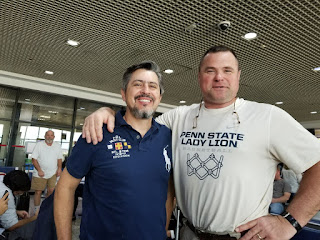This was our final day of touring. We left Passo Fundo early to head an hour or
so west to visit with the leadership of a large cooperative called Cotrijal with
more than 6000 members and over 460 million in revenues. They were in the
process of organizing a large Ag Progress Days type event called Expodirecto
Cotrial which attracts more than 200,000 people each year with around $600
million in deals each year. We met with
the Coop leaderships and discussed of the challenges and opportunities the
cooperative provides. This was organized more as an independent cooperative
like the old Agway stores in PA and they even operated some grocery and hardware
stores. They were advocates new technology
and innovation and have staff agronomists that work with members to fine tune management. Key profit centers were
soy, wheat, barley, canola, dairy and pork production. Soybean yields of coop members are
significantly higher than the state average.
After the discussion with the leadership we visited the exposition site
and some of the soybean trial plots that were established to showcase insect
management.


We returned to Passo Fundo for lunch and then headed to the
EMBRAPA Wheat station for a visit of several field trials and then joined them an indoor
session on some research updates. In the
outdoor trials we first saw a demonstration of a planter equipped with an in
row subsoiling knife. Also we reviewed a
forage trial and found that 11 cuts of alfalfa are possible in this region
producing 12 tons of forage annually. In a third trial we reviewed a crop
rotation study that showed when wheat is grown as a winter crop within three
years of each other, diseases can have a significant impact on yield. Wheat is not grown on every farm in the
winter and there seems to be more potential to use the winter for crop or cover
crop production in the region that is currently being done.
After several more presentations indoors we had a wrap up
session among tour members to review what we had learned on our trip.They had an interesting display of crop root sysems in plexiglas that we viewed. We shared
our thoughts on sustainability issues we encountered in Brazilian soybean
production, the economics of soybean production, and some of the key take home
messages we would be bringing back.
We finished the day with a BBQ at a facility near EMBRAPA Wheat where we thanked our guests for the great visit and hospitality. There was a
lot of great one on one engagement here between groups.









 Because of the nutrient savings they were able to suspend fertilizer applications for five years following a drought and this had a significant economic impact.
Because of the nutrient savings they were able to suspend fertilizer applications for five years following a drought and this had a significant economic impact.

 We reviewed the
critical need for IPM, importance of roots and straw in no-till Brazilian soybean production. We also learned about inoculant use here and
some of the new combinations that they are working with.
We reviewed the
critical need for IPM, importance of roots and straw in no-till Brazilian soybean production. We also learned about inoculant use here and
some of the new combinations that they are working with.

